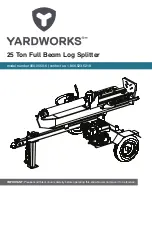
6
tank indoors.
Keep grounded conductive objects, such as
tools, away from exposed, live electrical parts
and connections to avoid sparking or arcing.
These events could ignite fumes or vapors.
Always stop the engine and allow it to cool
before
fill
ing the fuel tank. Never remove
the cap of the fuel tank or add fuel while the
engine is running or when the engine is hot.
Do not operate the machine with known leaks
in the fuel system.
Loosen the fuel tank cap slowly to relieve any
pressure in the tank.
Never
overfill
the fuel tank. Fill the tank to no
more than 1/2” below the bottom of the
fi
ller
neck to provide space for expansion as the
heat of the engine can cause fuel to expand.
Replace all fuel tank and container caps
securely and wipe up spilled fuel. Never
operate the unit without the fuel cap securely
in place.
Avoid creating a source of ignition for spilled
fuel. If fuel is spilled, do not attempt to start
the engine but move the machine away
from the area of spillage and avoid creating
any source of ignition until fuel vapors have
dissipated.
When fuel is spilled on yourself or your
clothes, wash your skin and change clothes
immediately.
Store fuel in containers
specificall
y designed
and approved for this purpose.
Store fuel in a cool, well-ventilated area, safely
away from sparks, open
fl
ames, or other
sources of ignition.
Never store fuel or a machine with fuel in the
tank inside a building where fumes may reach
a spark, open
flame
, or any other source of
ignition, such as a water heater, furnace, or
clothes dryer. Allow the engine to cool before
storing in any enclosure.
Hydraulic system safety
The hydraulic system of the machine requires
careful inspection along with the mechanical
parts. Be sure to replace frayed, kinked,
cracked, or otherwise damaged hydraulic
hoses or hydraulic components.
Hydraulic
fluid
can result in severe burns. Fluid
Regularly check to see that keys and adjusting
wrenches are removed from the machine area
before starting it. A wrench or a key that is left
attached to a rotating part of the machine may
result in personal injury.
Avoid accidental starting. Be sure the engine’s
switch is off before transporting the machine or
performing any maintenance or service on the
unit. Transporting or performing maintenance
or service on a machine with its switch on
invites accidents.
I f t h e m a c h i n e s h o u l d s t a r t t o v i b r a t e
abnormally, stop the engine (motor) and
check immediately for the cause. Vibration is
generally a warning sign of trouble.
Engine safety
This machine is equipped with an internal
combustion engine. Do not use on or near any
unimproved, forest covered, or brush covered
land unless the exhaust system is equipped
with a spark arrester meeting applicable local,
state, or federal laws.
Under Australian Law
, a spark arrester is
to
be fitted to the engine.
A spark arrester, if
used, must be maintained in effective
working order by the operator.
Never start or run the engine inside a closed
area.
The
exhaust
fumes
are
dangerous, containing carbon monoxide, an
odorless and deadly . Operate this unit
only in a well-ventilated outdoor area.
Do not tamper with the engine to run it
at excessive speeds. The maximum engine
speed is preset by the manufacturer and is
within safety limits. See engine manual.
Keep a Class B
fire
extinguisher on hand when
operating this log splitter in dry areas as a
precautionary measure.
Fuel safety
Fuel is highly
fl
ammable, and its vapors can
explode if ignited. Take precautions when
using to reduce the chance of serious personal
injury.
When
refilling
or draining the fuel tank, use
an approved fuel storage container while in
a clean, well-ventilated outdoor area. Do not
smoke, or allow sparks, open
flam
es, or other
sources of ignition near the area while adding
fuel or operating the unit. Never
fi
ll the fuel
LOG SPLITTER


































